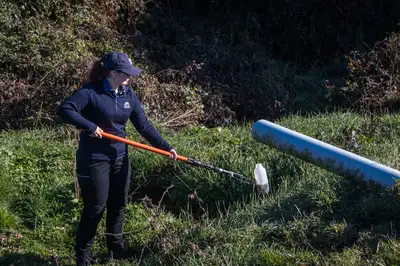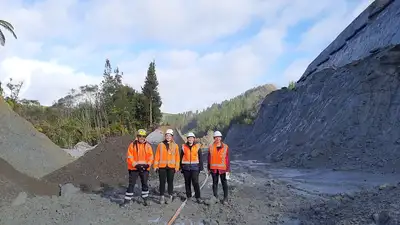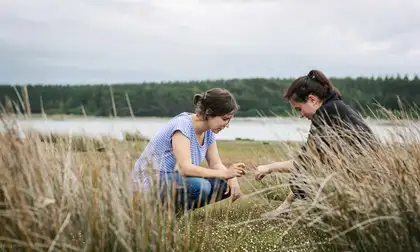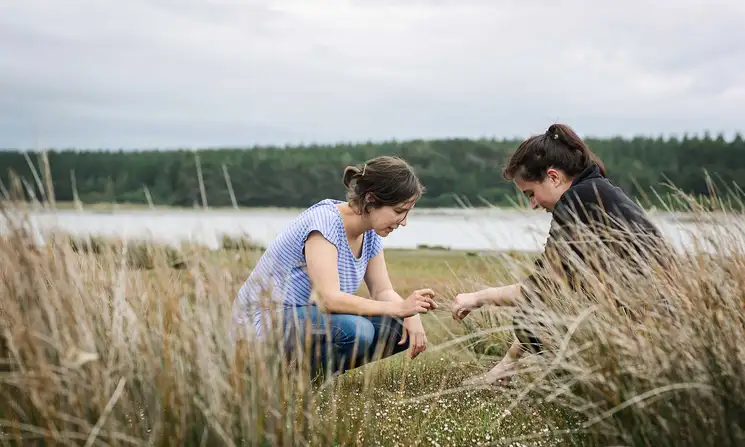Postgraduate students fortunate to earn an appointment on an MBIE Vision Mātauranga Capability Fund (VMCF) benefit from building academic research capability, relationship building with Māori communities and learning from mātauranga Māori. Massey University's VMCF placed postgraduate students speak about this experience as a professional game-changer and a personal life-changing opportunity.
Celeste Bevins (Master of Earth Science, First Class Honours, 2019) and Jonathan Quinn (Master in Environmental Management, First Class Honours, 2017) employ their acquired VMCF skills and knowledge in their current everyday mahi. Their experiences allow them to make a real impact on Aotearoa’s water and land health, as well as on building a sustainable infrastructure for us all.
Safeguarding our water’s wairua – Celeste Bevins
Dr Katherine Holt contracted soon to be graduated student Celeste Bevins to conduct work on Lake Horowhenua core samples that Holt and Professor Jonathan Proctor had collected in their VMCF partnership with Muaūpoko. Bevins, initially planning to study volcanology, shifted her postgraduate focus to understanding environmental change because of the VMCF placement, which was more aligned with her own journey and felt would have real positive impact.
Bevins grew up swimming at her favourite Taranaki watering holes, which brought her first-hand experience of the often effluent polluted waterways. The opportunity to have lunch with Muaūpoko folks at the marae and work with the VMCF team on the polluted Lake Horowhenua gave her understanding of “the lake as a life source and blood. To feel what they felt and how the lake has been degraded.” She was part of the team who brought the Western science to the project, but she says, “I then connected to what I was doing in a spiritual way. It had a feeling of greater meaning – that I was doing it for the greater good.” This deep connection gave her the persistence to continue her studies, too, as earning a postgraduate degree can be very challenging.

Celeste water sampling during an FDE (farm dairy effluent) inspection.
With successful completion of the master’s degree, she became a Taranaki Regional Council Compliance Officer where, she says, “I work at the coal face of environmental protection.” Newly hired, she monitored consented activities for water, land and air discharge (industry, dairy farming and earthworks) and addressed reports of unauthorised discharges. She is also part of the Regional Oil Spill Response Team. Bevins explains that they are able to track the majority of reported violation or contamination sources. For example, she was able to track down many years of faecal contamination within the Urenui River and estuary to a significant number of poorly operating and/or incorrectly installed septic systems. Her investigation and subsequent engagement with the Urenui community led to repairs, upgrades and the installation of new septic systems, new resource consents and, ultimately, less water contamination.
In her current mahi, Bevins uses her expertise investigating serious pollution incidents and providing technical expertise on the Mt Messenger Bypass earthworks consent. Waka Kotahi – New Zealand Transport Agency are constructing a new transport link between Uruti and Ahititi through the Mimi and Mangapepeke catchments. For the past year, she has been directly applying the VMCF skills she gained to this highly sensitive area: Ngāti Tama hold the areas wetlands as taonga. There are “waterways everywhere,” Bevins describes, so “we have to ensure that construction is not having unintended environmental effects. The earthworks runoff has to be directed into treatment systems before entering waterways. Sediment can alter the clarity of water and can affect fish life: the substrate gets smothered, which reduces available habitat and associated food sources, and their gills can become damaged by the abrasive action of sediment within the water column, meaning that they won’t be able to function properly.”

Bevins (second from the right) with representatives from the Mt Messenger Alliance and Ngāti Tama.
Her VMCF experience working with Muaūpoko and Holt and Proctor’s leadership has prepared her well for this collaborative mahi. Ngāti Tama serve as the cultural monitors “on site every step of the way. Therefore, iwi and Council are working together.” Bevins knows that passion is important. She explains, “I’m meeting people with the same passions. We’re not so separate, we have similar goals. They have a lot to offer this process.” Traditionally, iwi and councils have often operated as separate entities, but she sees this process as “council working with instead of on top of them.”
Her comprehensive knowledge and experience gained through the VMCF experience and her studies, coupled with her recently acquired investigative skills, has resulted in cases Bevins investigated being prosecuted through the courts. She is able to play a critical role in holding those individuals accountable who pollute the environment.
The faecal contamination issue mentioned earlier was initially brought to the Council’s attention by iwi, too. Because she was on that project from the start, she was working with them, following up and asking if they were satisfied with the outcome and management of the clean-up. She was making sure they were “bringing it full circle back to iwi.”
Learn about the work of Muaūpoko and the Lake Horowhenua Trust
Building a kaupapa for sustainable infrastructure – Jonathan Quinn
Jonathan Quinn immigrated to Aotearoa New Zealand after earning a geography degree in Ireland and spending some time living and traveling in the Middle East and Australia. He had always been interested in working in the planning and/or environmental fields and enrolled in Massey’s Master of Environmental Management to build his knowledge base and credentials. Jonathan initially planned to do a theory-focused thesis on offshore wind energy, but Dr Phil Murray offered him a placement opportunity on the Taiepe Tiketike Parihaka Papakainga Trust VMCF project he and Dr Ralph Sims were co-leading.
Jonathan was attracted instantly to the Parihaka project’s heavy focus on sustainability and, once on placement, “thoroughly enjoyed being part of the research team that looked at various sustainable infrastructure options, as well as ownership models and maintenance plans with the Parihaka community.” His research was submitted successfully as his thesis.
The VMCF Parihaka placement experience provided a strong foundation for his current professional role as a Development Manager with New Ground Capital. The Parihaka mahi taught him that the kaupapa Māori research methodology adopted by the project, along with ongoing community input, is crucial to ensuring valuable outcomes for all project partners.
The placement also required real-world project management, which is a major aspect of his current role. Specifically, his company is working on a variety of build-to-rent housing projects, a much-needed gap in the current market. They are also working on a project that involves building resilient communities and are working with various organisations to deliver affordable housing through their Housing Equity Fund. The experience and skills he developed while working on the Parihaka project are extremely valuable both personally and professionally. He is “very appreciative of the warm welcome and support I received from the Parihaka community and fellow researchers throughout the placement.”
Learn more about Taiepa Tiketike, Passive Resistance to Climate Change at Parihaka
Whakaaweawe
The connections and placements VMCF offers our future kaitiaki and change-makers are significant. These two stories are a snapshot of the ongoing impact of this research capability funding opportunity that brings Aotearoa New Zealand quietly into a stronger Tiriti-led country.
The VMCF research capability projects support a bicultural inquiry into global wicked problems in a specifically Aotearoa New Zealand context. Bevins and Quinn represent a new generation of Pākehā and tauiwi, respectively, who professionally uphold our aspirational bicultural values as they catalyse further impact for a healthy and sustainable future Aotearoa New Zealand.













